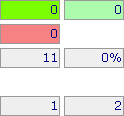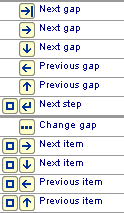The exercise control panel contains displays and controls that you use when working on an exercise.
- As a general principle, display elements only appear or are enabled when their use makes sense in the current context.
- All control elements present an informative pop-up message when the cursor hovers over them.
The meaning and function of the elements on the control panel are easily understood. Nevertheless, for the sake of completeness, the following sections describe the elements in detail.
Score meters
The score meters are shown when an evaluated exercise is currently loaded. The meters display the current score data for the exercise.
The following description is also given in the section 'Your scores'.

Every time you evaluate your work in an exercise a score is produced. This score is displayed in the control panel in the following fields:
![]() Result field Correct 1:
Number of answers correct first time.
Result field Correct 1:
Number of answers correct first time.
![]() Result field Correct 2:
Number of answers correct after one or more attempts.
Result field Correct 2:
Number of answers correct after one or more attempts.
![]() Result field Incorrect:
Number of incorrect answers.
Result field Incorrect:
Number of incorrect answers.
![]() Meter field Question
quantity: Number of questions in the exercise.
Meter field Question
quantity: Number of questions in the exercise.
![]() Meter field Percentage:
Percentage score.
Meter field Percentage:
Percentage score.
![]() Meter field Attempt
number: Number of attempts made so far.
Meter field Attempt
number: Number of attempts made so far.
![]() Meter field Maximum
attempts: Total number of attempts allowed.
Meter field Maximum
attempts: Total number of attempts allowed.
The colour-coding of the three result fields corresponds to the colour-coding applied to the gaps after evaluation.
The scores are updated on each evaluation.
The evaluate button
This button is only displayed when an evaluated exercise is currently loaded.
- The evaluation button is used to initiate an evaluation of the current answers in the exercise.
- It is also used to 'reset' the exercise for a further attempt.
The text displayed on the button reflects its current function:
![]() Click to evaluate the
exercise.
Click to evaluate the
exercise.
![]() Click to make a
further attempt on incorrect gaps.
Click to make a
further attempt on incorrect gaps.
![]() The exercise is
finished. Either you have got everything right or you have run out of attempts.
The exercise is
finished. Either you have got everything right or you have run out of attempts.
All these functions can also be carried out using keyboard shortcuts.
Navigation buttons
When an exercise is one in a series of exercises at the same hierarchical level the control panel will display a set of three navigation buttons that allow you to move between the exercises in the group.
![]()
The buttons only apply to navigation within the scope of the current group, for example 'Previous exercise' will not go beyond the first exercise in the current group. Their effect is the same as clicking on the relevant entry in the module tree.
If a previous or a next exercise is not available the respective button will be inactive.
Click 'Previous' to go to the previous exercise in the current exercise group.
Click 'Next' to go to the next exercise in the current exercise group.
Click 'Menu' to go to the 'parent page' for the current exercise group.
Other buttons
The ![]() button
restarts the exercise completely. In order to prevent accidental use during an
exercise the button is located away from the other controls, although it
logically belongs to the evaluation group.
button
restarts the exercise completely. In order to prevent accidental use during an
exercise the button is located away from the other controls, although it
logically belongs to the evaluation group.
Clicking on the ![]() button
stops tooltips being displayed when the cursor is over most of the active
elements on the page and on the control panel. When tooltips are switched off
the text of the button changes to
button
stops tooltips being displayed when the cursor is over most of the active
elements on the page and on the control panel. When tooltips are switched off
the text of the button changes to ![]() ;
clicking on this button will cause tooltips to be displayed once more. Note
that the tooltip on this button is always shown.
;
clicking on this button will cause tooltips to be displayed once more. Note
that the tooltip on this button is always shown.
Clicking on the ![]() button
stops the display of the keyboard shortcuts table (just below the button). When
the table is not displayed the text of the button changes to
button
stops the display of the keyboard shortcuts table (just below the button). When
the table is not displayed the text of the button changes to ![]() ;
clicking on this button will cause the shortcuts to be displayed once more.
;
clicking on this button will cause the shortcuts to be displayed once more.
Table of keyboard shortcuts
This table show the keyboard shortcuts that are available for the current section of the exercise page. Since there may be several exercise types on a page, each of which has its own shortcuts, the contents of this table may change as you move around the exercise page.
The table is divided into two sections:
- Navigation shortcuts, which are keyboard shortcuts that you can use to move from gap to gap within the exercise. These are normally the same for all exercise types.
- Operation keys, which are keyboard shortcuts that you can use to change the contents or the states of gaps and options.
The images in the table represent graphically the key combinations to be used for a shortcut. A tooltip describing the key combination is shown when the cursor is over the graphic. Here is an example of a typical table of keyboard shortcuts.

The following is an overview of the key symbols used and their meaning. The [modifier] key is held down while the second key is pressed and can be the Ctrl key or the Alt key or even both of these together.
![]() Any
alphanumeric key (the space key is usually most convenient).
Any
alphanumeric key (the space key is usually most convenient).
![]() Left
arrow key
Left
arrow key
![]() Down
arrow key
Down
arrow key
![]() Right
arrow key
Right
arrow key
![]() Up
arrow key
Up
arrow key
![]() [modifier] + left
arrow key
[modifier] + left
arrow key
![]() [modifier] + down
arrow key
[modifier] + down
arrow key
![]() [modifier] + right
arrow key
[modifier] + right
arrow key
![]() [modifier] + up
arrow key
[modifier] + up
arrow key
![]() [modifier] + page
down key
[modifier] + page
down key
![]() [modifier] + page
up key
[modifier] + page
up key
![]() [modifier] + return
key
[modifier] + return
key
![]() No
navigation shortcuts available (shown when the order of selecting gaps is
forced)
No
navigation shortcuts available (shown when the order of selecting gaps is
forced)
![]() Return
key
Return
key
![]() Tab
key. Note: Some browsers interpret the tab key in different ways; for this
reason it is usually best to avoid using this key.
Tab
key. Note: Some browsers interpret the tab key in different ways; for this
reason it is usually best to avoid using this key.